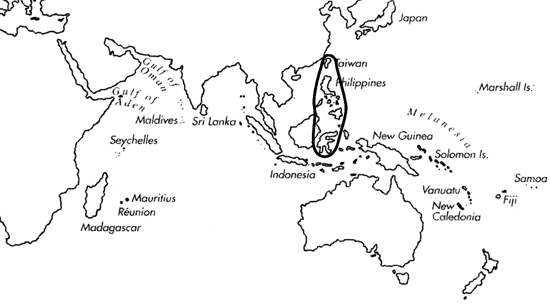Range: Taiwan, Philippines, and Indonesia (Sulawesi).
Description: Moderately small (shells from Philippines and Sulawesi) to medium-sized (shells from Taiwan), light to moderately light. Last whorl narrowly conical or narrowly conoid-cylindrical to slightly pyriform; outline slightly convex at adapical two-thirds, straight to concave below. Aperture very narrow. Siphonal canal often deflected to the dorsal side. Shoulder angulate to carinate, almost smooth to weakly tuberculate. Spire of moderate height to high, stepped; outline nearly straight to slightly sigmoid. Larval shell of 3.5-4 whorls, maximum diameter 0.9-1 mm. First 8-9 postnuclear whorls weakly tuberculate. Teleoconch sutural ramps concave, with radial threads and 1 increasing to 5-8 spiral grooves. Entire last whorl with axially striate spiral grooves separating ribs basally and ribbons adapically; 1-3 fine spiral ribs replace ribbons just below shoulder.
| Shell Morphometry | ||
|---|---|---|
| L | 32-55 mm | |
| RW | 0.05-0.10 g/mm | |
| RD | 0.41-0.47 | |
| PMD | 0.80-0.91 | |
| RSH | 0.20-0.28 | |
Ground colour beige, variably tinged with light brown. Last whorl of shells from Taiwan (Pl. 56, Figs. 9, 11) usually with brown dots on spiral ribbons; dots not clustered into spiral bands but often arranged in axial streaks or lines. Larval shell light brown, with a brown sutural line. Postnuclear sutural ramps sparsely maculated with brown radial markings and with brown dots along outer margin. Aperture white to light brown.
Periostracum brown, thin, translucent, smooth.
Habitat and Habits: In 100-400 m on mud; trawled together with C. orbignyi orbignyi.
Discussion: C. pseudorbignyi is similar to the co-occurring C. orbignyi orbignyi. Shells of the latter species attain larger size (85 mm), are strongly tuberculate, and have a colour pattern of spiral bands on the last whorl, while the colour pattern of C. pseudorbignyi includes only less prominent separate brown dots. For comparison with C. insculptus, see the Discussion of that species.

C. pseudorbignyi range map
This section contains verbatim reproductions of the accounts of 316 species of Conus from the Indo-Pacific region, from Manual of the Living Conidae, by Röckel, Korn and Kohn (1995). They are reproduced with the kind permission of the present publisher, Conchbooks.
All plates and figures referred to in the text are also in Röckel, Korn & Kohn, 1995. Manual of the Living Conidae Vol. 1: Indo-Pacific Region.
The range maps have been modified so that each species account has it own map, rather than one map that showed the ranges of several species in the original work. This was necessary because each species account is on a separate page on the website and not confined to the order of accounts in the book.